How to Fix Microsoft Error Code 0x426-0x0
Some Windows users are encountering the error Code: 0x426-0x0 (ERROR_SERVICE_NOT_ACTIVE) whenever they attempt to open a program from the Microsoft Office suite. This problem is reported to occur on Windows 7, Windows 8.1, and Windows 10.

After investigation of this particular issue, it turns out that the 0x426-0x0 error code with Microsoft Office can occur due to multiple causes. Here’s a shortlist of potential culprits:
- Disabled Click-to-Run service – One of the most common causes that will trigger this error code is a scenario in which the main Microsoft Office Click-to-Run service is Disabled from the Services screen. In this case, you can resolve the issue by enabling the service and setting the status to Automatic from the Services screen.
- Corrupted Office installation – According to some affected users, this problem can also occur due to a corrupted Office installation. It can either be related to file corruption or it can be rooted in a Registry entry. In this case, you should be able to fix the problem by using the auto-repair function of Microsoft Office.
- AVG TuneUp interference – As it turns out, there are several different 3rd party utilities (most commonly AVG TuneUp) that are known to interfere with several Office applications (particularly programs from the Office365 suite). In this case, uninstalling the conflicting optimization program should fix the problem entirely.
- Conflicting old office installation – If your Windows installation currently holds multiple Office installation, you can expect conflicts between certain program iterations, particularly if they end up sharing registry files. In this case, the only way to fix is it to uninstall the older Office installation.
Method 1: Enabling the Click-to-Run Service
If you see this error code coming up when you attempt any program from the Office suite, the first thing you should do is make sure that the relevant service that handles this (Microsoft Office Click-To-Run) is permitted to run.
In most cases, users that encountered the 0x426-0x0 error code have reported that in their case, the problem occurred because the Click to Run service was disabled from the Services screen.
If this scenario is applicable, you’ll be able to fix the problem by accessing the Services screen and setting the status of the Microsoft Office Click to Run service to Automatic. Here’s a quick guide on how to do this:
- Open a Run dialog box by pressing Windows key + R. Next, type ‘services.msc‘ inside the text box and press Enter to open up the Services utility. When you see the UAC (User Account Control) prompt, click Yes tog rant administrative privileges.
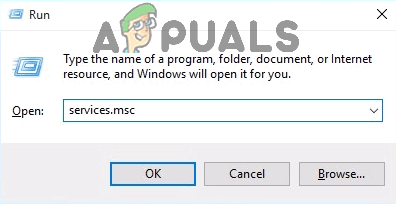
Type “services.msc” into the Run dialog and press Enter - Inside the Services screen, click on the Services (Local) tab from the left section of the screen, then move over to the right section and scroll down through the list of services until you spot the Microsoft Office Click-to-Run Service.
- When you see it, right-click on the correct service and click on Properties from the newly appeared context menu.
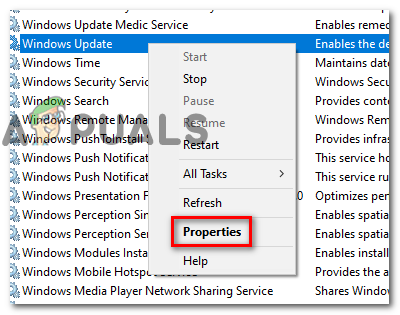
Accessing the Properties screen of the Windows Update service - Once you’re inside the Properties screen, select the General tab, and investigate whether the Startup type is set to Disabled. If it is, change it to Automatic by utilizing the associated drop-down menu.
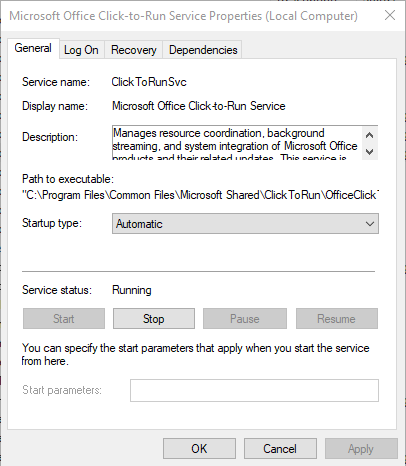
Forcing the Microsoft Office Click-to-Run service to start Note: If the Service status currently shows as Stopped, click on Start to start the service.
- Once you have ensured that the Microsoft Office Click-to-Run service is Enabled and configured to launch at every system startup, reboot your computer and repeat the action that was previously causing the 0x426-0x0 error code.
If the same problem is still occurring, move down to the next potential fix below.
Method 2: Repairing the Office Installation
As some affected users have confirmed, this problem can occur due to a corrupted Office installation. It can either be related to some files that all your applications share or it can be rooted in a Registry entry.
This problem is typically reported to occur in situations where an AV (or a different type of scan) ended up quarantining some files belonging to the Microsoft Office suite or if there was an unexpected interruption while Office Programs were installing or updating.
If one of the scenarios described above seems like it could be applicable, you should be able to fix the problem by repairing the Office installation along with every associated registry file.
Here’s a quick guide on initiating a complete Microsoft Office repair via the Program and Features menu:
- Open up a Run dialog box by pressing Windows key + R. Next, type ‘appwiz.cpl’ inside the text box and press Enter to open up the Programs and Features menu.

Type appwiz.cpl and Press Enter to Open Installed Programs List - Once you’re inside the Programs and Features menu, scroll down through the list of installed applications and locate your Office installation.
- When you manage to locate it, right-click on the Microsoft Office and choose Change from the newly appeared context menu.

Accessing the repair menu of the Microsoft Office installation - Once you get to the next screen, choose the Online Repair option, and ensure that your Internet connection is stable. After you confirm the operation, wait for it to complete without closing the window.

Repairing the Office Installation - Once the process is complete, reboot your computer and wait for the next startup to complete. After your computer boots back up, launch the Office application that was previously failing once again and see if the problem is now resolved.
If you still end up seeing the same 0x426-0x0 error code, move down to the next potential fix below.
Method 3: Uninstalling AVG TuneUp (if applicable)
As some affected users have reported, this problem is often caused by a 3rd party utility released by AVG called AVG TuneUp Tool. According to some affected users, this maintenance 3rd party utility has the potential of interfering with quite a few Office programs by tampering with heir cached data.
If this scenario is applicable and you have AVG Tune Up (or an equivalent tool) installed on your system, you should be able to fix this problem by uninstalling the problematic 3rd party tool and restarting your computer.
Here’s a quick guide on how to do this:
- Press Windows key + R to open up a Run dialog box. Next, type ‘appwiz.cpl’ inside the text box and press Enter to open up the Programs and Files menu.

Type appwiz.cpl and Press Enter to Open Installed Programs List - Once you’re inside the Programs and Features menu, scroll down through the list of installed applications and locate the AVG Tune Up utility (or the equivalent utility you want to uninstall).
- When you see it, right-click on it and choose Uninstall from the newly appeared context menu.
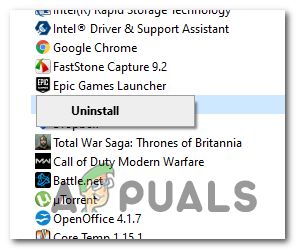
Uninstall the problematic program in Programs and Features - Next, follow the uninstallation prompt to get rid of the problematic 3rd party utility, then restart your computer and see if the issue was resolved at the next startup.
If the same error code 0x426-0x0 is still appearing when you attempt to open an Office application, move down to the next potential fix below.
Method 4: Uninstalling Old Office Installation/s
According to some affected users have confirmed, the error code 0x426-0x0 can also occur when you have 2 conflicting Office versions that are attempting to use the same registry keys. Typically, the error will occur when you try to open an Office app that’s using the same Registry files as an older installation.
If this scenario is applicable, you should be able to fix this problem by removing any old Office installation file that you no longer have any use for and you suspect might be contributing to the apparition of this error code.
A lot of affected users that were dealing with this problem have confirmed that they were finally able to fix the problem after uninstalling and removing any remnant files that might be triggering the error code 0x426-0x0.
Here’s a quick guide on how to do this:
- Press Windows key + R to open up a Run dialog box. Inside the text box, type ‘appwiz.cpl’ and press Enter to open up the Programs and Features window.

Type appwiz.cpl and Press Enter To Open Installed Programs Page - Once you’re inside the Apps & Features window, scroll down through the list of installed applications and locate the Old office installation that you suspect might be conflicting with the newer Office version. When you manage to locate it, right-click on it and choose Uninstall from the newly appeared context menu.
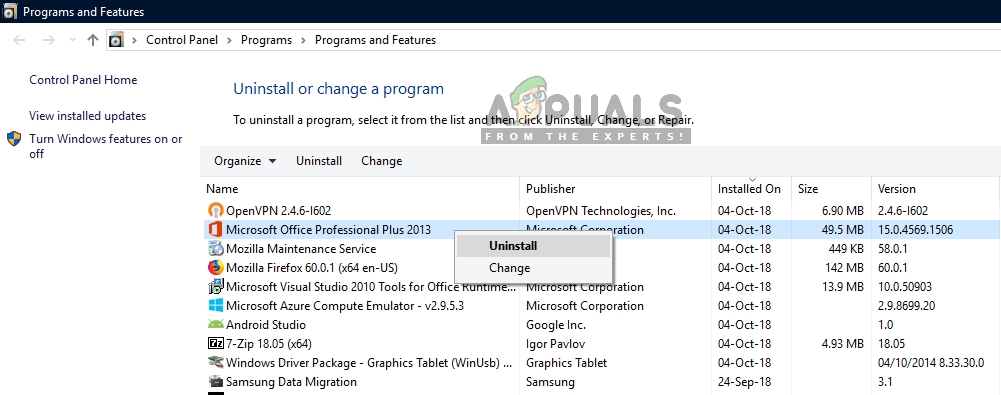
Uninstalling Microsoft Office entries in Control Panel Note: If you can’t find any entries from your old office installation, skip this step and move directly to step 4.
- Inside the uninstallation screen, follow the prompt to complete the uninstall steps, then reboot your computer manually if you’re not automatically prompted to do so.
- Once the next startup is complete, access the Office Troubleshoot page from any browser, then scroll down to the Problems while trying to install the Office section. Once inside, click on the Download button and wait until the SetupProd_OffScrub.exe file is downloaded.
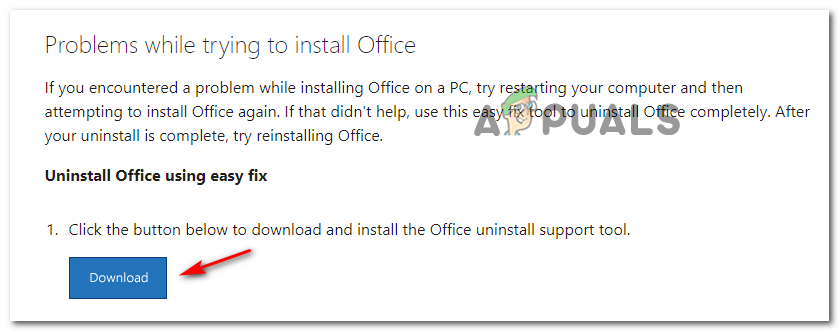
Downloading the SetupProd_OffScrub.exe utility - Once the executable is downloaded, double-click on SetupProd_OffScrub.exe and click on Install, then follow the on-screen prompts to remove any Office-related remnant files than might still cause this behavior.
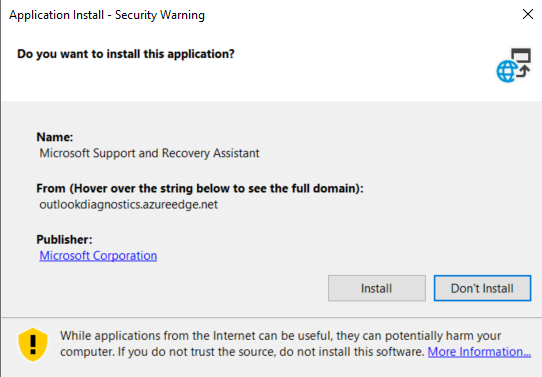
Installing the SetupProd_OffScrub.exe - Once the scrubbing procedure is complete, then restart your computer and wait for the next computer startup to complete.
- After the next startup is complete, open the Office application again and see if the error code 0x426-0x0 is now resolved.





